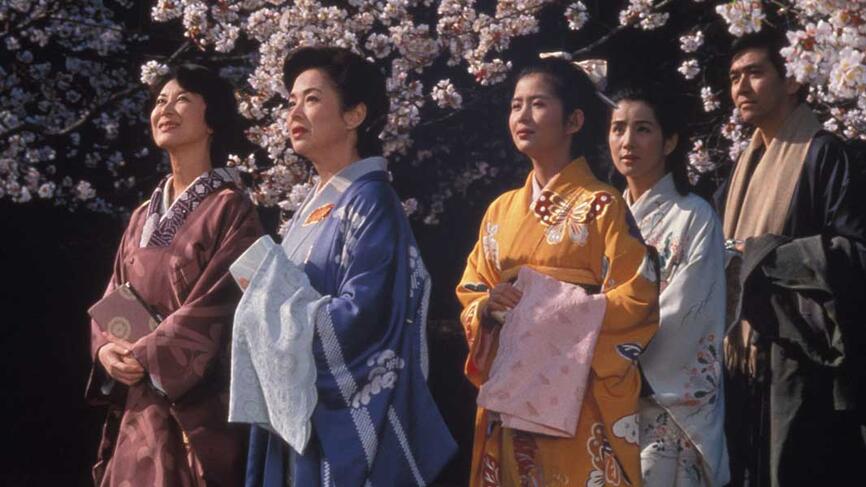Six Film Recommendations from Professor Mingwei Song to Check Out While Social Distancing
Looking to add to your movie watch list while you’re staying safe at home? Mingwei Song, associate professor of Chinese and an expert in modern Chinese literature, intellectual history, and film studies, shares six selections from some of the best Asian films available on Kanopy, an award-winning video streaming service with more than 30,000 independent and documentary films—you have free access to it thanks to your Wellesley email address.
Song chose the following films that he says are great but not necessarily well known. “I deliberately avoided internationally famous films such as Rashomon, Tokyo Story, and Rebels of the Neon Gods,” Song said “I tried to select some hidden treasures that I hope will bring joy, peace, hope, and intellectual strength during a time that poses challenges to everyone.”

The Music Room (1958, India)
The Music Room is a masterpiece that reminds me of the human tragedies and abstract sadness that I have seen in Ingmar Bergman and Federico Fellini, Ray’s contemporaries who also reached artistic maturity in the late 1950s. The film depicts the decline of an aristocratic house in the modern age, with a distinct cinematic style that pulls audience into a world of sounds and music. The sometimes subtle and sometimes dramatic changes of the soundtrack, including music and natural sound, give life to the decaying house as well as its lonely resident’s soul. The film’s masterful black and white cinematography responds to the music that is played to enliven the dead souls who saw a different world before the modern era arrived.

The Makioka Sisters (1983, Japan)
The film is a splendid adaptation of Japanese literary giant Jun’ichirō Tanizaki’s masterpiece Sasame-yuki. It’s the epic story of one of the four sisters of a declining Osaka merchant family, in the years leading up to the Pacific War, directed by Kon Ichikawa, a master filmmaker. The Makioka Sisters is one of Ichikawa’s late-career successes, and the film draws attention to its close study of the human nature through graceful depictions of the characters, their uttered words and unuttered minds, their relationships, their fading traditions, and the different attitudes toward modernization. The film offers spectacular display of traditional Japanese elements, including the spring cherry blossoms, the colorful, vivid kimono designs, and the pre-War manners of the upper-class Japanese families. The surface splendor contrasts with a darker, bleaker atmosphere surrounding the troubled characters toward the end of the film, with emerging clues to seduction, transgression, self-sacrifice outside the appropriate moral codes of the times, predicting an enormous change to Japanese society in the forthcoming War years.

JSA: Joint Security Area (2000, Korea)
Directed by Park Chan-wook, this film held the record as the highest-grossing film released in Korea for several years. JSA: Joint Security Area touches upon an extremely sensitive topic for the Korean audience: the DMZ, or the de-militarized zone. Its release echoed the South Koreans’ efforts for a peaceful reunification with the North, represented by President Kim Dae-chung’s “sunshine policy,” for which Kim won the Nobel Peace Prize in 2000. JSA builds up an elegant and well-constructed cinematic narration to reveal the sparks of humanity in a war-like environment. It focuses on the mystery surrounding bizarre relations involving two North Korean officers and two South Korean equivalents, leading to the woman investigator’s hypothesis that the four became friends despite their positions in the conflict of ideologies.

Norte, the End of History (2013, Philippines)
The director Lav Diaz is one of the leading filmmakers associated with the slow cinema movement, famous for his patient, precise, and well-paced cinematic narration. Notre, the End of History is 250 minutes long, and is loosely based on Dostoyevsky’s Crime and Punishment. The film opens with a seminar-like conversation among intellectuals who debate about justice and the capitalist system. One of them, a law student, later murders a moneylender, but another person, a worker, is arrested for the crime. The law student hesitates between confessing his crime and further destroying his life, later driving himself to near insanity. The wife of the worker struggles to raise their family. The film keeps using long takes and long shots, presenting a panoramic view of the common life in a society afflicted with a struggle between human fragility and heart of darkness. There appears to be no way for redemption. Some touching moments are hauntingly intensified portrayals of this inner struggle, such as the long shot showing the mother standing on a cliff with two children, as if looking directly into the abyss, and after a too-long minute, the mother holds the children together and returns to their road in the countryside. At the end of the film, some uplifting subtle change to the mother’s facial expression implies some hope, at least a hope for the survival.

Kaili Blues (2015, China)
Working with an extremely low budget, Bi Gan, at the age of 26, created this film and released it to worldwide acclaim. With a mesmerizing voiceover and poetic cinematography, Kaili Blues combines surrealism, dreamscape, realism, and tragedy in a carefully constructed narrative about memory, love, and time. Several plot lines are intertwined with clues that only show themselves after a second watching. Repeated watching is certainly more inspiring, giving viewers an epiphany not just about the film, but also life. The film centers on a mysterious connection between some surreal dreamlike moments and ordinary life scenes. A 45-minute-long take, almost half of the screening time, is a powerful representation of an imagined surreal space that speaks to the hidden aspects of reality, which orient the characters, or rather the audience, toward self-reflection and redemption. The film’s original Chinese title is Roadside Picnic, the name of a Russian science fiction novel that was made into the film Stalker by Andrei Tarkovsky, a master filmmaker who inspired Bi Gan.

Close-Up (1990, Iran)
No other film by Abbas Kiarostami feels more personal than Close-Up, a docufiction that is based on a true event related to Kiarostami’s profession as a filmmaker. He consistently uses close-ups in the film to capture the protagonist’s facial expressions so as to achieve a neorealist representation of the character’s social behavior as well as his inner life. The revelation of the inner life is a result of Kiarostami’s filming, just as the impersonating of a film director is built upon the protagonist’s deep love for the filmmaker Mohsen Makhmalbaf, another leading Iranian New Wave director.


